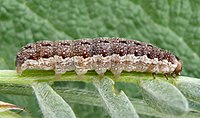Tiliacea citrago, the orange sallow, is a species of moth of the family Noctuidae. It is found in Europe as far east as the Caucasus Mountains and the Urals.
| Orange sallow | |
|---|---|

| |
| Scientific classification | |
| Kingdom: | |
| Phylum: | |
| Class: | |
| Order: | |
| Family: | |
| Genus: | |
| Species: | T. citrago
|
| Binomial name | |
| Tiliacea citrago | |
| Synonyms | |
| |

Technical description and variation edit
The wingspan is 28–33 mm. Forewing yellow, thickly freckled with orange; veins finely ferruginous; lines ferruginous brown, the median thick; all running more or less parallel to each other and to termen; the inner oblique outwards from costa to subcostal vein and again from vein 1 to inner margin where it touches the median; stigmata of the ground colour, with brown rings; the orbicular large, round; both with brown centres; submarginal line formed of disconnected pale lunules edged inwardly with darker; hindwing pale yellow;- aurantiago Tutt is a darker form, deeper orange, and sometimes darkened by grey dusting, occurring in Britain: incolorata equally meriting a distinctive name is a rare form, ab. incolorata ab. nov. [Warren] in which the ground colour is pure pale ochreous, without any orange freckling, the veins and lines faintly brownish, the stigmata all but obsolete; the fringe pale; hindwing white; I have seen only 1 example, a female, certainly British, but without exact locality; the form subflava Ev., from Denmark, the Baltic, St. Fetersburg, and the Ural Mts.; recorded also from Asia Minor, has quite a different appearance, the 3 lines, inner, outer, and submarginal being accompanied by brown bands of uniform width, the stigmata marked with brown, and the hindwing with brown veins and terminal border.[1]
Biology edit
The moth flies from August to October depending on the location.
Larva grey brown with a pink tinge; dorsal and subdorsal lines whitish; between them a black spot surrounded with white tubercles on each segment; spiracular stripe yellowish white, broad. The larvae feed on the leaf-buds and later the leaves of Tilia species, including Tilia cordata and Tilia platyphylla.
References edit
- ^ Seitz, A. Ed., 1914 Die Großschmetterlinge der Erde, Verlag Alfred Kernen, Stuttgart Band 3: Abt. 1, Die Großschmetterlinge des palaearktischen Faunengebietes, Die palaearktischen eulenartigen Nachtfalter, 1914
External links edit